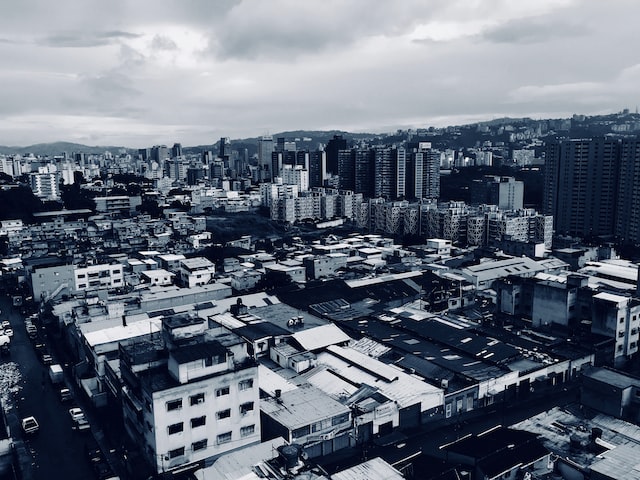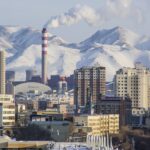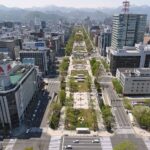Caracas has a lot of public transportation options that are quite simple to use. The Metrobus is a sizable, cutting-edge bus network and is the most often used means of transportation. Both inhabitants and visitors find it to be a convenient method of transportation within the city. There are additional rental options for automobiles and taxis, with fees changing depending on the vehicle and the distance. Several private businesses also provide shuttle services to and from airports and other areas. It is advisable to prepare ahead of time and be mindful of your surroundings because the city’s public transportation can occasionally be a bit disorganized and busy.
Metro system in Caracas – Basic information
The metro system in Caracas is a convenient and affordable way to get around the city. It is run by the Metro de Caracas and consists of five lines, which span a total of 63.6 kilometers and 49 stations. It is the largest metro system in Venezuela and serves over 2 million passengers every day. The lines are color-coded, making it easy to identify which line you are on. The metro system also offers a number of discounts and passes, such as student discounts, weekly passes, and monthly passes. The metro system in Caracas is an easy and efficient way to get around the city.
The lines of the Caracas subway system
- The Line 1: On January 2, 1983, the first 8-station line began operations, and it was expanded a total of three more times before the most recent and last rail expansion of this route took place on November 19, 1989. The Capitolio station was remodeled so that passengers can transfer to and from the El Silencio station through a walkway that connects the two stations. Additionally, the Plaza Venezuela station has been renovated not once but twice; the first time, in 1994, it was done so that passengers could transfer to line 3, and the second time, it was done so that passengers could access the Zona Rental station (2006).
- The Line 2: On October 4, 1987, a trial run of a limited-service was made available to the public. El Silencio was included in the full scope of the expansion on November 6, 1988. The original goal of the line has been rethought; before the opening of Line 4 on July 18, 2006, trains from the terminal station at El Silencio served both the Las Adjuntas and Zoológico terminal stations. Now, those stations are served by trains that originate at Line 4, which began service on July 18, 2006.
- The Line 3: The first line of service, which ran between Plaza Venezuela and El Valle, was inaugurated on December 18th, 1994. In 2006, a portion of the La Rinconada extension began to function as intended. (Passengers were required to switch trains at the El Valle stations). After the completion of three new stops in 2010, the line became fully operational and could transport passengers between Plaza Venezuela and La Rinconada.
- The Line 4 : The only difference between the two distinct lines of the Caracas Metro at the moment is that they travel to different terminal stations. Other than that, there is no differentiation between the lines. Line 4 became known as line 2 not long after it first opened its doors.
- Los Teques Metro: Commenced operations in 2006. Also run by Metro de Caracas. serves in all intents and purposes as a continuation of Line 2/4.
Map of Caracas Metro 2023 – Free Download in PDF
A tremendously helpful tool for exploring the city is the Caracas Metro 2023. The map is accessible for free download in PDF format, which makes it simple to access and store. Users may quickly and easily plan their trips using the map, which shows all Caracas Metro stations, lines, and connections in an easy-to-read manner. This practical map makes it easy for people to navigate Caracas and reach their destination. Everybody traveling or residing in the city needs the Caracas Metro 2023 map.
Public transport tickets in Caracas – Best types for travelers & actual prices
In Caracas, using the public transit system is a terrific way to get around and discover the city. Travelers have a variety of options, from bus cards to metro tickets, each with its own benefits and costs.
The Metro is the most widely used mode of public transit in Caracas. You can purchase one-way or multi-trip Metro tickets. You will need to pay 1 Bs for a single ride ticket, and 8 Bs for a 10-ride pass. If you intend to travel frequently, you can also pay Bs. 150 for a monthly pass.
The bus is yet another well-liked mode of public transit in Caracas. Depending on the route, bus tickets typically cost between Bs. 1.50 and Bs. 2.50 at any of the ticket offices situated at bus stops. Moreover, a 10-trip pass for Bs. 15 is available.
In Caracas, there are taxi services accessible in addition to the metro and buses. Although they can be more expensive than other kinds of public transit, taxis are an excellent method to travel around the city swiftly and safely. Depending on the distance and time of day, taxi fares might start at Bs. 8 and go as high as Bs. 40.
The best choice for visitors staying in Caracas for three days is to get a 10-trip Metro and bus pass. You will benefit from the convenience of being able to make several excursions without worrying about having to pay for tickets each time. The 10-trip pass is also the most affordable choice because it will cost you less than a taxi journey.
Timetables & Schedules of Caracas Metro system
During weekdays, the Caracas Metro system is open from 6 am to 11 pm, while on weekends, it is open from 7 am to 11 pm. It has 49 stations altogether, divided into four lines. Line 1 is red, Line 2 is green, Line 3 is blue, and Line 4 is yellow. Trains run around every five minutes during rush hour and about every ten minutes during off-peak hours, depending on the time of day. One of the safest and most dependable transit options in the city is the Caracas Metro system, which is a great way to move around the city.
What Are Other Options For Public Transportation In Caracas?
In Caracas, the Venezuelan capital, public transit is an essential component of daily life. Although the Metro is the most often used mode of transportation in the city, both residents and visitors have access to a number of additional options. The many forms of public transportation offered in Caracas will be described in detail in this page.
The most popular kind of public transportation in Caracas is the bus. The entire city is served by bus routes, and both public and private buses are available. Government-operated public transportation costs about 10 bolivars per trip, on average. The cost of a private bus often ranges between 20 and 40 bolivares. Buses might be highly crowded during rush hours, but they are often secure and dependable.
Taxi: Taxis are a well-liked transportation choice in Caracas, and they are typically trustworthy and safe. Throughout the city, there are both authorized and unauthorized taxis. Taxi fares normally range between 40 and 50 bolivars, and official taxis typically have yellow license plates. Unauthorized taxis are typically less expensive yet less secure. When riding in an illegal taxi, it’s crucial to pay attention to your surroundings.
Trolleybus: A trolleybus is a vehicle that resembles a bus but is powered by electricity from overhead lines. In Caracas, the trolleybus is a well-liked transportation choice, and the ticket is often approximately 10 bolivars. Several routes in the city are served by the trolleybus, however power shortages often make the service unpredictable.
The Aeromóvil is a system of aerial cable cars that links the suburbs of Caracas with the city center. The system is still being expanded, despite being relatively new. Depending on the distance, fares range from 10 to 20 bolivares. Despite the fact that it makes several stops, the Aeromóvil might be a slow means to move around the city.
In conclusion, Caracas offers a variety of public transportation choices, including buses, taxis, the metro, and the Aeromóvil. Every alternative has benefits and drawbacks, so it’s crucial to weigh the price, speed, and safety of each before making a choice. Regardless of your preference, public transit in Caracas is a cheap and practical way to move around the city.
How To Get From Simón Bolívar International Airport (ccs) To The City Center With Public Transport?
With public transportation, getting to the city center from Simón Bolvar International Airport (SBIA) can be simple. You will find all the information you require in our guide to make it safely, comfortably, and affordably from the airport to the city center.
Locating the public transit alternatives at SBIA is the first step. Several transportation alternatives are available at the airport, including a shuttle service, taxis, buses, and trains. The most practical choice is the shuttle service, which is run by Metrobus, the official shuttle service of the airport. The shuttle runs between the airport and the city center, stopping at a number of locations along the way. The cost of the shuttle is approximately $15.
- Take the bus as your third choice. A network of bus lines connects the SBIA to the city core. The bus fare is approximately $2.50.
- Taking the train is the final choice. A train station at the SBIA links the airport and the city’s core. The train ticket costs about $3.50.
- Taking a taxi from the airport to the city center is the second choice. Taxis are a practical way to get from the airport to the city center and are available twenty-four hours a day. Taxis normally cost roughly $25 per trip.
Whichever route you decide to take, it’s critical to be aware of the safety measures required when taking public transportation. It is advised that you always carry some kind of identification with you and to avoid carrying big sums of money or expensive items. Also, it’s crucial to always be alert of your surroundings and to avoid going alone at night. You may get from SBIA to the city center quickly and safely by remembering this advice. You can be sure that you will reach your destination securely and on time whether you use the shuttle, cab, bus, or rail.
What kind of sightseeing do you have to see if you visit Caracas for the first time?
Venezuela’s main city, Caracas, is a dynamic, energetic place with lots of things to see and do. Caracas has everything to offer everyone, from breathtaking natural wonders to exciting cultural activities. The top places to go in Caracas are listed below.
While exploring Caracas, an excellent place to start is the Avila National Park. Both inhabitants and tourists like visiting this enormous national park, which offers breathtaking views of the city and its surroundings. To get breathtaking 360-degree views of the city, visitors can ride a cable car to the top of the park. There are numerous walks and pathways to discover in the Avila National Park for people seeking to get closer to nature.
Another fantastic destination in Caracas is the Central University of Venezuela. One of the oldest universities in Latin America, this magnificent institution was established in 1721 and is home to a number of historical and cultural landmarks. Visitors can tour the university’s stunning buildings, landscaped grounds, vast library, and art collections.
A spectacular attraction in the city is the Caracas Cathedral. This magnificent structure dates back to the 16th century and is regarded as one of the most significant places of worship in the city. There are numerous elaborate paintings and sculptures in the cathedral, as well as a magnificent altar. The underground crypt, which is claimed to be the final resting place of a number of famous people from Venezuelan history, is also open to visitors.
The Sabana Grande Boulevard is a fantastic place to unwind after a day of sightseeing in Caracas. This bustling street is lined with cafes, bars, and eateries, making it the ideal location to unwind and take in the energetic vibe of the city. The numerous stores and marketplaces that line the avenue, which sell a variety of souvenirs and other goods, are also open to visitors.
These are but a few of the most popular sites to see in Caracas. Caracas offers something for everyone, whether you want to explore the city’s rich culture or just unwind and take in the dynamic atmosphere.
Summary of our tour guide for Caracas
The capital and one of the biggest cities in Venezuela is Caracas. It is a thriving city with a diverse range of architectural styles, an active culture, and delicious cuisine. In Caracas, using the public transportation system is an affordable and practical way to travel. There are buses, trolleybuses, and metro lines in addition to the Metrobus, which is a well-liked kind of public transit. The city also has a wide variety of taxis, ridesharing services, and automobile rental options.
Top 5 FAQs and answers about Caracas public transport?
- What are the greatest transportation options in Caracas?
- Metrobus is the best means of transportation in Caracas. It is far more affordable than using a taxi and the most dependable and effective choice. Several areas of the city are connected by the bus rapid transit system known as the Metrobus.
- What is the cost of the Metrobus?
- A single ride on the Metrobus costs only VEF 3 (or roughly US$0.07). For VEF 30 for a day, VEF 40 for two days, and VEF 50 for three days, you can purchase a pass that gives you access to unlimited rides.
- What more public transportation choices are there?
- In Caracas, there are a number of different public transportation choices besides the Metrobus. They consist of the MetroCable, a cable car system, and the Metro de Caracas, a subway system. Also, there are taxis, municipal buses, and private buses.
- How safe is the public transportation system?
- Caracas’s public transportation system is usually regarded as secure, but it’s always a good idea to remain cautious and aware of your surroundings. Avoid traveling alone at night if at all feasible, and keep an eye out for pickpockets.
- From where can I learn more?
- Visit the Metro de Caracas official website to learn more about the city of Caracas’s public transportation system. You may find comprehensive information on routes, prices, and other connected subjects here.
Useful links
- Official website of public Caracas transport company








